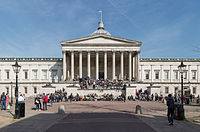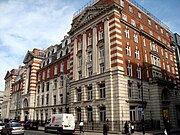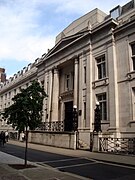
A | B | C | D | E | F | G | H | CH | I | J | K | L | M | N | O | P | Q | R | S | T | U | V | W | X | Y | Z | 0 | 1 | 2 | 3 | 4 | 5 | 6 | 7 | 8 | 9
 | ||||||
| Latin: Collegium Universitatis Londinensis[1] | ||||||
Other name | UCL | |||||
|---|---|---|---|---|---|---|
Former names | London University (1826–1836) University College, London (1836–1907) University of London, University College (1907–1976) University College London (1977–2005; remains legal name) | |||||
| Motto | Latin: Cuncti adsint meritaeque expectent praemia palmae | |||||
Motto in English | Let all come who by merit deserve the most reward | |||||
| Type | Public research university | |||||
| Established | 1826 (University status 2023) | |||||
| Endowment | £156.8 million (2023)[2] | |||||
| Budget | £1.933 billion (2022/23)[2] | |||||
| Chair | Victor L. L. Chu[3] | |||||
| Visitor | Sir Geoffrey Vos (as Master of the Rolls ex officio)[4] | |||||
| Chancellor | Anne, Princess Royal (as Chancellor of the University of London) | |||||
| President and Provost | Michael Spence | |||||
Academic staff | 9,585 (2021/22)[5] | |||||
Administrative staff | 6,075 (2021/22)[5] | |||||
| Students | 46,830 (2021/22)[6] | |||||
| Undergraduates | 23,800 (2021/22)[6] | |||||
| Postgraduates | 23,030 (2021/22)[6] | |||||
Other students | 895 (studying wholly overseas; 2021/22) | |||||
| Location | London, England 51°31′29″N 00°08′01″W / 51.52472°N 0.13361°W | |||||
| Campus | Urban | |||||
| Colours | Purple and blue celeste[7] | |||||
| Affiliations | ||||||
| Website | ucl | |||||
University College London (branded as UCL[8][9][10]) is a public research university in London, England. It is a member institution of the federal University of London, and is the second-largest university in the United Kingdom by total enrolment[11] and the largest by postgraduate enrolment.
Established in 1826 as London University (though without university degree-awarding powers) by founders inspired by the radical ideas of Jeremy Bentham, UCL was the first university institution to be established in London, and the first in England to be entirely secular and to admit students regardless of their religion.[12][13] It was also among the first university colleges to admit women alongside men in 1878, two years after University College, Bristol.[14] Intended by its founders to be England's third university, politics forced it to accept the status of a college in 1836, when it received a royal charter and became one of the two founding colleges of the University of London, although it achieved de facto recognition as a university in the 1990s and formal university status in 2023. It has grown through mergers, including with the Institute of Ophthalmology (in 1995), the Institute of Neurology (in 1997), the Royal Free Hospital Medical School (in 1998), the Eastman Dental Institute (in 1999), the School of Slavonic and East European Studies (in 1999), the School of Pharmacy (in 2012) and the Institute of Education (in 2014).
UCL has its main campus in the Bloomsbury area of central London, with a number of institutes and teaching hospitals elsewhere in central London and has a second campus, UCL East, at Queen Elizabeth Olympic Park in Stratford, East London. UCL is organised into 11 constituent faculties, within which there are over 100 departments, institutes and research centres. UCL operates several museums and collections in a wide range of fields, including the Petrie Museum of Egyptian Archaeology and the Grant Museum of Zoology and Comparative Anatomy, and administers the annual Orwell Prize in political writing. In 2022/23, UCL had a total income of £1.93 billion, of which £527 million was from research grants and contracts.[2] The university generates around £10 billion annually for the UK economy, primarily through the spread of its research and knowledge (£4 billion) and the impact of its own spending (£3 billion).[15]
UCL is a member of numerous academic organisations, including the Russell Group and the League of European Research Universities, and is part of UCL Partners, the world's largest academic health science centre.[16] It is considered part of the "golden triangle" of research-intensive universities in southeast England.[17] UCL has publishing and commercial activities including UCL Press, UCL Business and UCL Consultants.
UCL has many notable alumni, including the founder of Mauritius, the first Prime Minister of Japan, one of the co-discoverers of the structure of DNA, and Coldplay members. UCL academics discovered five of the naturally occurring noble gases, discovered hormones, invented the vacuum tube, and made several foundational advances in modern statistics. As of 2022[update], 30 Nobel Prize winners[18] and three Fields medallists[19] have been affiliated with UCL as alumni or academic staff.
History
1826 to 1836 – London University

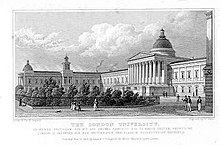
UCL was founded on 11 February 1826 as an alternative to the Anglican universities of Oxford and Cambridge.[20] It took the form of a joint stock company, with shares sold for £100 (equivalent to £10,600 in 2023) to proprietors, under the name of London University, although without legal recognition as a university or the associated right to award degrees.[21][22][23] London University's first warden was Leonard Horner, who was the first scientist to head a British university.[24]

Despite the commonly held belief that the philosopher Jeremy Bentham was the founder of UCL, his direct involvement was limited to the purchase of share No. 633, at a cost of £100 paid in nine instalments between December 1826 and January 1830. In 1828, he did nominate a friend to sit on the council, and in 1827, attempted to have his disciple John Bowring appointed as the first professor of English or History, but on both occasions his candidates were unsuccessful.[25] However, Bentham is commonly regarded as the "spiritual father" of UCL, as his ideas on education and society were influential with the institution's founders, particularly James Mill (1773–1836) and Henry Brougham (1778–1868).[26]
In 1828, the chair of political economy at London University was created, with John Ramsay McCulloch as the first incumbent.[27] In 1829, the university appointed the first professor of English in England, although the course concentrated on linguistics and the modern teaching of English – studying English literature – was introduced by King's College London in 1831.[28] In 1830, London University founded the London University School, which would later become University College School.[29] In 1833, the university appointed Alexander Maconochie, secretary to the Royal Geographical Society, as the first professor of geography in Britain.[30][31] Classes in medicine began at the opening of the college in 1828, and in 1834 University College Hospital (originally North London Hospital) opened as a teaching hospital for these classes, which were organised into a faculty of medicine in 1836.[32]
1836 to 1900 – University College, London
After almost a decade of attempting to win recognition as a university and the right to award degrees, including an Address to the Crown from the House of Commons, the proprietors of London University accepted the government's proposal to establish the University of London as an independent examining body, accepting the status of a college for their institution.[33] As a result, the proprietors of London University were incorporated by royal charter under the name University College, London on 28 November 1836. On the same day, the University of London was created by royal charter as a degree-awarding examining board for students from affiliated schools and colleges, with University College and King's College, London being named in the charter as the first two affiliates.[33][34] The first students from UCL and King's matriculated as undergraduates in 1838 and the first degrees were awarded to students of the two colleges in 1839.[35]
There had been an intention to establish a course in engineering at the college's opening but no professor was appointed until 1840 or 1841, after engineering courses had started at Durham University (1837) and King's College London (1838).[36][37] The Slade School of Fine Art was founded as part of University College in 1871, following a bequest from Felix Slade.[38]
In 1878, the University of London gained a supplemental charter making it the first British university to be allowed to award degrees to women. The same year, UCL admitted women to the faculties of Arts and Law and of Science, although women remained barred from the faculties of Engineering and of Medicine (with the exception of courses on public health and hygiene).[39][40] UCL's admission of women in 1878 came almost three decades after Bedford College became the first institution to offer university-level education for women in Britain, and the establishment of the University of London's General Examination for Women in 1868.[41][42]
The Ladies' Educational Association held classes for women from 1868, taught by professors from UCL but independently of the college. From 1871 to 1872 these were held inside the college building, although still independently of the college. From 1872, some professors, particularly Edward Poynter of the Slade, started to admit women to their classes.[43] The full opening on the faculties of arts, science and law in 1878 came two years after the admission of women alongside men at the University of Bristol from its foundation (as University College Bristol) in 1876.[44] The first woman to officially enrol in architecture at UCL was Gertrude Leverkus in 1915,[45] although Ethel and Bessie Charles had been allowed to audit classes in the 1890s.[46] Women were finally admitted to medical studies during the First World War in 1917, although limitations were placed on their numbers after the war ended.[47]
A new royal charter granted to the University of London in 1858 effectively removed the affiliation of colleges to the university. Dissatisfaction from the colleges and the desire for a "teaching university" in London led to royal commissions that reported in 1888 and 1892 and the reconstitution of the university under the University of London Act 1898.[33]
1900 to 1976 – University of London, University College
| University College London (Transfer) Act 1905 | |
|---|---|
| Act of Parliament | |
 | |
| Citation | 5 Edw. 7. c. xci |
| Dates | |
| Royal assent | 11 July 1905 |
| Text of statute as originally enacted | |
Following the University of London's reconstitution in 1909, transforming it from an examining board to a federal university with constituent "schools", UCL, became a school of the University of London. While most of the colleges that became schools of the university retained their autonomy, UCL chose to be merged into the university in 1907 under the University College London (Transfer) Act 1905 (5 Edw. 7. c. xci) and surrendered its legal independence in return for gaining a greater say in the running of the university.[33] Its formal name became University of London, University College, although for most informal and external purposes the name "University College, London" (or the initialism UCL) was still used. As of 2022,[update] it remains listed as "University of London: University College" on US Federal Student Aid applications.[48]

1900 also saw the decision to appoint a salaried head of the college. The first incumbent was Carey Foster, who served as Principal (as the post was originally titled) from 1900 to 1904. He was succeeded by Gregory Foster (no relation), and in 1906 the title was changed to Provost to avoid confusion with the principal of the University of London. Gregory Foster remained in post until 1929.[49][50][51] In 1906, the Cruciform Building was opened as the new home for University College Hospital.[52] UCL opened the first department and chair of chemical engineering in the UK, funded by the Ramsay Memorial Fund, in 1923.[53]
In 1904, Francis Galton donated £1,000 to the University of London for a eugenics laboratory; this transferred to UCL in 1907 with Karl Pearson as its director.[54] UCL apologised for its "fundamental role in the development, propagation and legitimisation of eugenics" in 2021.[55]
In 1911, UCL received an anonymous donation of £30,000 (equivalent to £3,860,000 in 2023) for a building for its school of architecture. In 1919 the donor consented to being named as Herbert Bartlett and the school was renamed in his honour.[56]
UCL sustained considerable bomb damage during the Second World War, including the complete destruction of the Great Hall, the Carey Foster Physics Laboratory and the Ramsay Laboratory. Fires gutted the library and destroyed much of the main building, including the dome; it was not until 1954 that the main building was fully restored. The departments were dispersed across the country to Aberystwyth, Bangor, Gwynedd, Cambridge, Oxford, Rothamsted near Harpenden, Hertfordshire and Sheffield, with the administration at Stanstead Bury near Ware, Hertfordshire.[57] The first UCL student newspaper, Pi, was founded in 1946.[58] The Institute of Jewish Studies relocated from Manchester to UCL in 1959.[59]
The Mullard Space Science Laboratory was established in 1967.[60] In 1973, Peter Kirstein's research group at UCL became one of only two international nodes on the ARPANET, later becoming part of SATNET.[61][62] UCL's interconnection between the ARPANET and early British academic networks was the first international heterogeneous resource sharing network.[63] UCL played a significant role in the very earliest experimental Internet work and adopted TCP/IP in 1982, ahead of the ARPANET.[64][65]
The college's senior common room, the Housman Room, remained men-only until 1969. After two unsuccessful attempts, a motion was passed that ended segregation by sex at UCL. This was achieved by Brian Woledge (Fielden Professor of French at UCL from 1939 to 1971) and David Colquhoun, at that time a young lecturer in pharmacology.[66]
1976 to 2005 – University College London
In 1976, a new charter restored UCL's legal independence, although still without the power to award its own degrees.[67][68] Under this charter the college became formally known as University College London. This name abandoned the comma used in its earlier name of "University College, London".
In 1993, a reorganisation of the University of London meant that UCL and other colleges gained direct access to government funding and the right to confer University of London degrees themselves. This led to UCL being regarded as a de facto university in its own right.[69][70]
Mergers were a major feature of this period of UCL's history. In 1986, the college merged with the Institute of Archaeology.[71] In 1988, UCL merged with the Institute of Laryngology & Otology, the Institute of Orthopaedics, the Institute of Urology & Nephrology and Middlesex Hospital Medical School.[71] Middlesex and University College hospitals, together with the Elizabeth Garrett Anderson Hospital and the Hospital for Tropical Diseases, formed the University College London Hospitals NHS Trust in 1994.[72]
Mergers continued in the 1990s, with the Institute of Child Health joining in 1995, the School of Podiatry in 1996[73] and the Institute of Neurology in 1997.[71][74] In 1998, UCL merged with the Royal Free Hospital Medical School to create the Royal Free and University College Medical School (renamed the UCL Medical School in October 2008). In 1999, UCL merged with the School of Slavonic and East European Studies[75][76] and the Eastman Dental Institute.[71]
Proposals for a merger between UCL and Imperial College London were announced in 2002.[77] The proposal provoked strong opposition from UCL teaching staff and students and the AUT union, which criticised "the indecent haste and lack of consultation", leading to its abandonment by UCL provost Sir Derek Roberts.[78][79]
From 2005
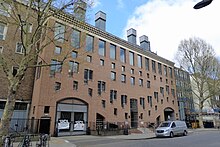
UCL was granted its own taught and research degree awarding powers in 2005,[80] and all UCL students registered from 2007/08 qualified with UCL degrees.[81] The same year, UCL adopted a new corporate branding under which the name University College London was replaced by the initialism UCL in all external communications.[82]
UCL established the UCL School of Energy & Resources (later UCL Australia) in Adelaide, Australia, in 2008 as the first campus of a British university in the country.[83] The school was based in the historic Torrens Building in Victoria Square.[84] In 2011, the mining company BHP Billiton agreed to donate AU$10 million to UCL to fund the establishment of two energy institutes – the Energy Policy Institute, based in Adelaide, and the Institute for Sustainable Resources, based in London.[85] UCL Australia closed in December 2017, with academic staff and student transferring to the University of South Australia.[86] Since 2018, UCL and the University of South Australia have offered joint master's degrees in data science and in energy systems with study in Adelaide and London.[87]
In 2011, UCL announced plans for a £500 million investment in its main Bloomsbury campus over 10 years, as well as the establishment of a new campus, UCL East, next to the Olympic Park in Stratford in the East End of London.[88] In 2018, UCL opened UCL at Here East, at the Queen Elizabeth Olympic Park, offering courses jointly between the Bartlett Faculty of the Built Environment and the Faculty of Engineering Sciences.[89][90] The first undergraduate students, on a new Engineering and Architectural Design MEng, started in September 2018.[91] One Pool Street, the first building on the UCL East campus, opened in November 2022. UCL East was officially opened, along with the Marshgate building that completed phase 1 of the development, in September 2023 by Olympic gold medalist and UCL alumna Christine Ohuruogu.[92][93]
UCL continued to grow through mergers with smaller colleges in the University of London. On 1 January 2012 the School of Pharmacy, University of London merged with UCL, becoming the UCL School of Pharmacy within the Faculty of Life Sciences.[94][95] UCL and the Institute of Education formed a strategic alliance in October 2012,[96] followed by a full merger in December 2014.[97][98][99][100]

UCL paid tens of thousands of pounds to settle ten sexual harassment claims against staff in the 2017/18 academic year, a rise from four cases the year before. Following pressure from victims, and after physicist Emma Chapman won the legal right to speak freely about her abuse at the university, UCL announced in 2018 that it would abandon non-disclosure settlements in settlements.[101][102] In 2020, UCL became the first Russell Group university to ban romantic and sexual relationships between lecturers and their students.[103]
It was discovered in 2018 that an annual eugenics conference, the London Conference on Intelligence, had been held at UCL, as an external paid event, between 2014 and 2017.[104] An enquiry found that the organiser, an honorary lecturer, did not correctly follow the room booking procedure, including claiming that no controversial topics would be discussed, leaving the university unaware of the nature of the conference.[105] Following the revelation, UCL announced in 2018 that it would launch an enquiry into the university's historical links with eugenics.[106] This reported in 2020,[107] but covered only historical eugenics and did not address the 2014–17 conferences, leading to a majority of the authors refusing to sign the final report.[108] The Galton Lecture Theatre, Pearson Lecture Theatre and Pearson Building were all renamed in 2020,[108] and in 2021 UCL apologised for its part in promoting eugenics during the first half of the 20th century.[55][109] UCL was criticised (along with Oxford, Imperial and other London universities) in 2021 for accepting money from the Alexander Mosley Charitable Trust, established to hold the fortune left to Max Mosley by his father, British fascist leader Oswald Mosley. UCL received £500,000 to establish a forensic evidence interpretation laboratory.[110][111][112]
Following the passing of the University of London Act 2018, which allowed member institutions to become universities in their own right while remaining part of the University of London, UCL applied for university status in 2019.[113] The application was approved by the Office for Students in 2022 and a supplemental charter was sealed on 17 April 2023, granting UCL university status.[114]
Campus and locations
Bloomsbury
UCL is primarily based in the Bloomsbury area of the London Borough of Camden, in Central London. The main campus is located around Gower Street, with many other departments close by in Bloomsbury.[115] Many health institutes are located close to associated hospitals, including the UCL Queen Square Institute of Neurology and the National Hospital for Neurology and Neurosurgery in Queen Square,[116] the UCL Great Ormond Street Institute of Child Health and Great Ormond Street Hospital for Children,[115] and the UCL Eastman Dental Institute and Eastman Dental Hospital.[117]
Historic UCL buildings in Bloomsbury include the grade I listed UCL Main Building, including the original Wilkins building designed by William Wilkins,[118] and, directly opposite on Gower Street, the early 20th century grade II listed Cruciform Building, the last major building designed by Alfred Waterhouse.[119][120] Nearby are the grade II listed Kathleen Lonsdale Building, UCL's first purpose-built chemistry laboratory,[121] and the grade II listed Rockefeller Building.[122] Elsewhere in Bloomsbury is the 1970s grade II* Institute of Education building by Denys Lasdun and Partners.[123] Much of the estate falls within the Bloomsbury Conservation Area, designated in 1968.[124] Important contemporary buildings include the School of Slavonic and East European Studies building (RIBA Award winner 2006)[125] and the Sainsbury Wellcome Centre for Neural Circuits and Behaviour building (LEAF Award for best façade design and engineering and overall winner 2016).[126]

UCL East
UCL has a second campus, UCL East, at the Queen Elizabeth Olympic Park in Stratford, east London. The first building, with three floors of teaching and research space as well as accommodation for 500 students in two towers, opened in 2022, and the second, with eight floors of teaching and research space, opened in 2023.[92][127] A further four buildings are planned for construction in the 2030s.[128] UCL also operates a campus within Here East, the former Olympic park media centre.[89]
Other sites

Elsewhere in Central London are the UCL Institute of Ophthalmology adjacent to Moorfields Eye Hospital in Clerkenwell,[129] the Royal Free Hospital and the Whittington Hospital campuses of the UCL Medical School, and a number of other associated teaching hospitals. The UCL School of Management is on levels 38 and 50 (penthouse) of One Canada Square in the financial district of Canary Wharf.[130] The UCL Observatory is in Mill Hill[131] and the Mullard Space Science Laboratory is based in Holmbury St Mary, Surrey.[132] The UCL Athletics Ground is in Shenley, Hertfordshire.[133]
Student housing
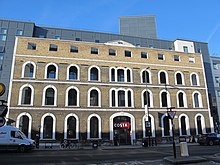
UCL owns 26 halls of residence with around 7,000 student beds.[134] The university guarantees accommodation to single full-time first-year undergraduate students who have not previously lived in London while studying at a university, and who make a firm acceptance of a place and apply for accommodation by 10 June each year, and to single overseas first-year postgraduates at UCL who have not previously lived in London while studying at a university, and who make a firm acceptance of a place and apply for accommodation by 30 June each year. Accommodation is also guaranteed for students who are under 18 at the start of the academic year and for students who are care-leavers.[135] There is only limited accommodation available in university halls for returning students and others who do not meet the criteria for a guaranteed place.[136] UCL students are also eligible, as students of a member institution of the University of London, to apply for places in the University of London intercollegiate halls of residence.[137]
In 2013, UCL's newly built New Hall student accommodation building on Caledonian Road, designed by Stephen George and Partners, was awarded the Carbuncle Cup and named the country's worst new building by Building Design magazine, with the comment "this is a building that the jury struggled to see as remotely fit for human occupation". Islington Council had originally turned down planning permission for the building, but this had been overturned on appeal. As it is classified as a hotel or guest house, it was exempt from many of the standards that cover residential buildings, such as having daylight in the rooms.[138][139]
The UCL East development includes 532 student rooms in One Pool Street, which opened in 2022.[140] Further accommodation will be available in the Marshgate building, expected to open in 2023, and at the second Pool Street site.[141]
Environmental initiatives
UCL's new Student Centre, which opened in 2019, was designed to be environmentally friendly and was one of only 320 buildings worldwide (at the time) to be certified outstanding by BREEAM.[142] This certification requires innovation throughout the design, engineering and construction process, and places the Student Centre among the top 1% of non-domestic buildings in the UK for sustainability.[143] The UCL Student Centre was a finalist at the Green Gown Awards in 2019.[144]
Also in 2019, UCL launched a Strategy for Sustainable UCL 2019–24, including three initiatives to promote sustainability. The Positive Climate initiative saw UCL pledge to have a 40% reduction in energy usage, all energy to come from renewables, and all UCL buildings to be carbon neutral by 2024, along with achieving net zero carbon emissions for UCL by 2030.[142] The Positive Climate initiative was the winner in the "2030 Climate Action" category at the 2020 Green Gown Awards.[145][146]
A second initiative, The Loop, promotes circular economy. UCL set a target of reducing waste per person by 20% between 2019 and 2024, while aiming for an 85% recycling rate and the elimination of single-use plastics on campus. The third initiative, Wild Bloomsbury, promotes biodiversity. UCL set a target of creating 10,000 m2 (1.0 ha; 2.5 acres) of biodiverse green space on campus by 2024.[142] The Strategy for a Sustainable UCL was a finalist in the "Sustainable Institution of the Year" category at the 2022 Green Gown Awards.[147]
Organisation and administration
Governance
The two main bodies in UCL's governance structure are the council and the academic board, both of which are established by the royal charter and with powers defined by the statutes.[148] There is also a University Management Committee, which is the executive committee responsible for the day-to-day operations of the institution. This comprises the President and Provost, the vice-presidents, the vice-provosts, the pro-provost of UCL East, the deans of the faculties, the chief financial officer, chief information officer, and chief people officer, the chief of staff, the general consul, the executive director of media and marketing, and the director of media relations.[149]
The senior leadership team at UCL includes the visitor, a position in English charity law that overseas the operation of the institution.[150] That there shall be a visitor of the college is specified by the royal charter, as is that the position is to be held by the Master of the Rolls, the second most senior judge in England and Wales.[148]
UCL's council comprises 20 members, of whom 11 are members external to UCL; seven are UCL academic staff, including the provost, three UCL professors and three non-professorial staff; and two are UCL students. The chair is appointed by council for a term not normally exceeding five years. The chair is ex officio chair of the honorary degrees and fellowships committee, nominations committee and remuneration and strategy committee.[151] As of April 2023,[update] the chair of the council is international businessman and UCL alumnus Victor Chu.[3]
The academic board plays a role similar to the senate in other institutions. It is the senior academic body responsible for advising council on academic matters and also elects academic members to council. It is, however, a much larger body than the senates at many other universities, including all professors as well as elected representatives of other academic and non-academic staff.[148][152]
UCL's principal academic and administrative officer is the President and Provost, who is also UCL's designated accountable officer for reporting to the Office for Students on behalf of UCL.[153] The provost is appointed by Council after consultation with the academic board, and is ex officio a member of council and chair of the academic board.[154] As of April 2023,[update] Michael Spence has been president and provost since January 2021, when he succeeded Michael Arthur.[155][156]
Vice-provosts are appointed by council on the recommendation of the provost or the academic board, to assist and advise the provost as required. The vice-provosts are members of the provost's senior management team. There are four vice-provosts (for education and student experience; health; research, innovation and global engagement; and faculties).[148][157] There are also four vice-presidents, who are also members of the senior management team but whose role and manner of appointment is not specified in the statutes, for strategy, external engagement, advancement and operations.[148][157]
The deans of UCL's faculties are appointed by the council and are members of the provost's senior management team. The deans' principal duties include advising the provost and vice-provosts on academic strategy, staffing matters and resources for academic departments within their faculty; overseeing curricula and programme management at faculty level; liaising with faculty tutors on undergraduate admissions and student academic matters; overseeing examination matters at faculty level; and co-ordinating faculty views on matters relating to education and information support.[151]
Faculties and departments


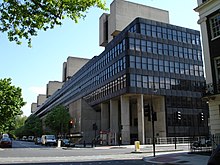
UCL's research and teaching is organised into eleven faculties, each of which contains a number of schools, departments and institutes.[158] The establishment of faculties and academic departments is formally the responsibility of UCL's council, with advice from the academic board.[159]
| Faculty[158] | Staff | Students | ||
|---|---|---|---|---|
| Undergraduates | Postgraduates | |||
| Taught | Research | |||
| Arts and Humanities | 620 | 2,684 | 943 | 226 |
| Bartlett (Built Environment) | 1,272 | 925 | 2,836 | 411 |
| Brain Sciences | 1,725 | 929 | 1,961 | 1,034 |
| Engineering Sciences | 667 | 4,373 | 2,791 | 1,122 |
| IOE (Education and Society) | 1,318 | 1,515 | 3,988 | 684 |
| Laws | 175 | 844 | 450 | 49 |
| Life Sciences | 964 | 2,632 | 1,084 | 592 |
| Mathematical and Physical Sciences | 1,135 | 3,927 | 929 | 680 |
| Medical Sciences | 1,321 | 2,356 | 1,287 | 430 |
| Population Health Sciences | 1,578 | 247 | 1,365 | 447 |
| Social and Historical Sciences | 1,101 | 4,130 | 2,054 | 488 |
There are also two academic units outside the faculty structure:[159]
- Sainsbury Wellcome Centre for Neural Circuits and Behaviour
- School of Slavonic and East European Studies (to join the Arts and Humanities faculty from 2023):[161] 193 staff; 559 undergraduate students; 57 taught postgraduate students; 29 research postgraduate students (2022/23)[160]
There are additional staff employed outside the faculty structure in the university administration.[160]
Finances
In the financial year ended 31 July 2020, UCL had a total income (excluding share of joint ventures) of £1.54 billion (2018/19 – £1.49 billion) and a total expenditure of £1.34 billion (2018/19 – £1.67 billion).[2] Key sources of income included £467.7 million from research grants and contracts (2018/19 – £481.1 million), £613.7 million from tuition fees and education contracts (2018/19 – £564.9 million), £227.9 million from funding body grants (2018/19 – £213.5 million) and £26.6 million from donations and endowments (2018/19 – £40.5 million).[2] At year end UCL had endowments of £143.2 million (31 July 2019 – £138.7 million) and total net assets of £1.49 billion (31 July 2019 – £1.29 million).[2]
Zdroj:https://en.wikipedia.org?pojem=University_College,_London
Text je dostupný za podmienok Creative Commons Attribution/Share-Alike License 3.0 Unported; prípadne za ďalších podmienok. Podrobnejšie informácie nájdete na stránke Podmienky použitia.
Antropológia
Aplikované vedy
Bibliometria
Dejiny vedy
Encyklopédie
Filozofia vedy
Forenzné vedy
Humanitné vedy
Knižničná veda
Kryogenika
Kryptológia
Kulturológia
Literárna veda
Medzidisciplinárne oblasti
Metódy kvantitatívnej analýzy
Metavedy
Metodika
Text je dostupný za podmienok Creative
Commons Attribution/Share-Alike License 3.0 Unported; prípadne za ďalších
podmienok.
Podrobnejšie informácie nájdete na stránke Podmienky
použitia.
www.astronomia.sk | www.biologia.sk | www.botanika.sk | www.dejiny.sk | www.economy.sk | www.elektrotechnika.sk | www.estetika.sk | www.farmakologia.sk | www.filozofia.sk | Fyzika | www.futurologia.sk | www.genetika.sk | www.chemia.sk | www.lingvistika.sk | www.politologia.sk | www.psychologia.sk | www.sexuologia.sk | www.sociologia.sk | www.veda.sk I www.zoologia.sk


